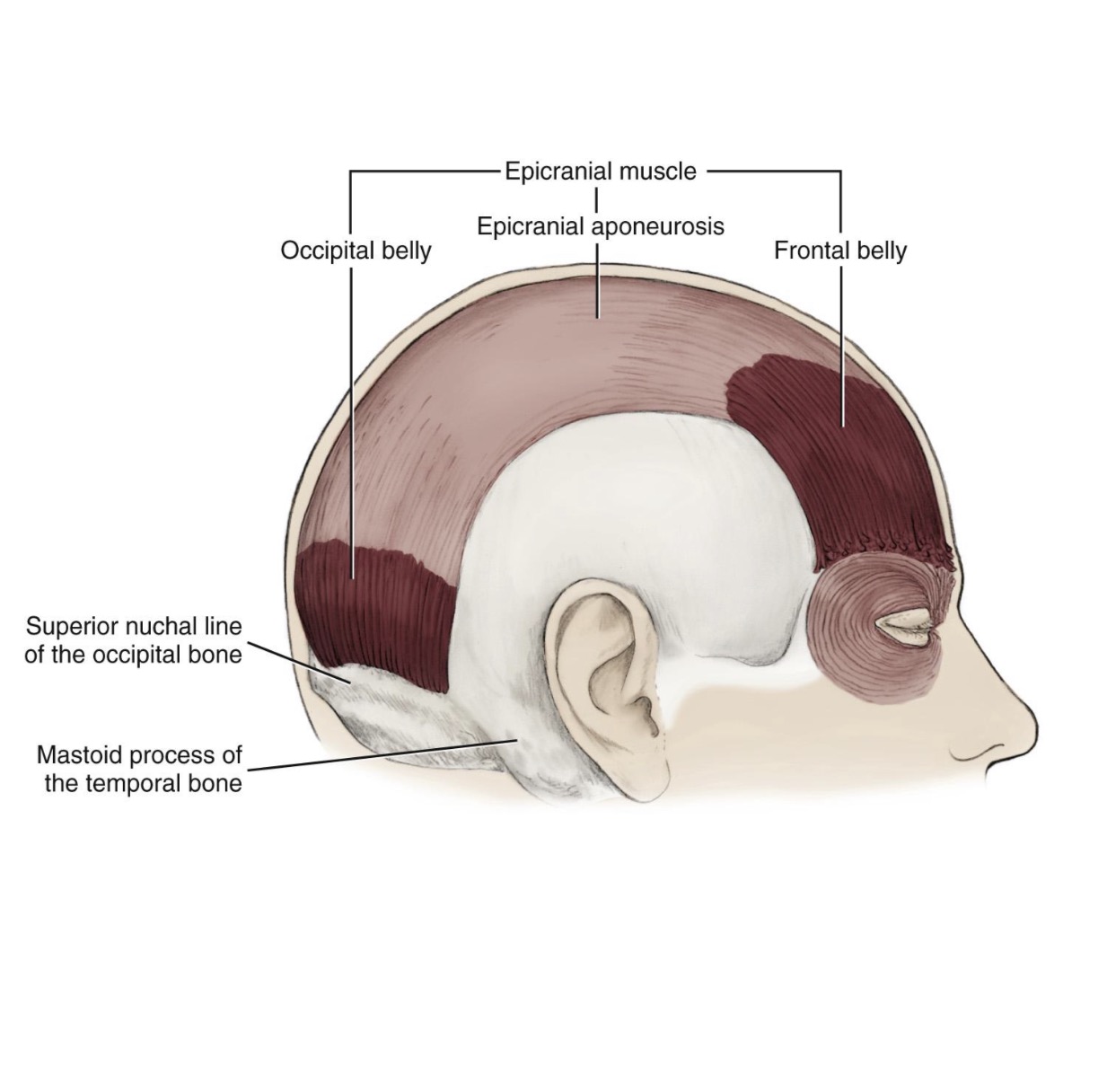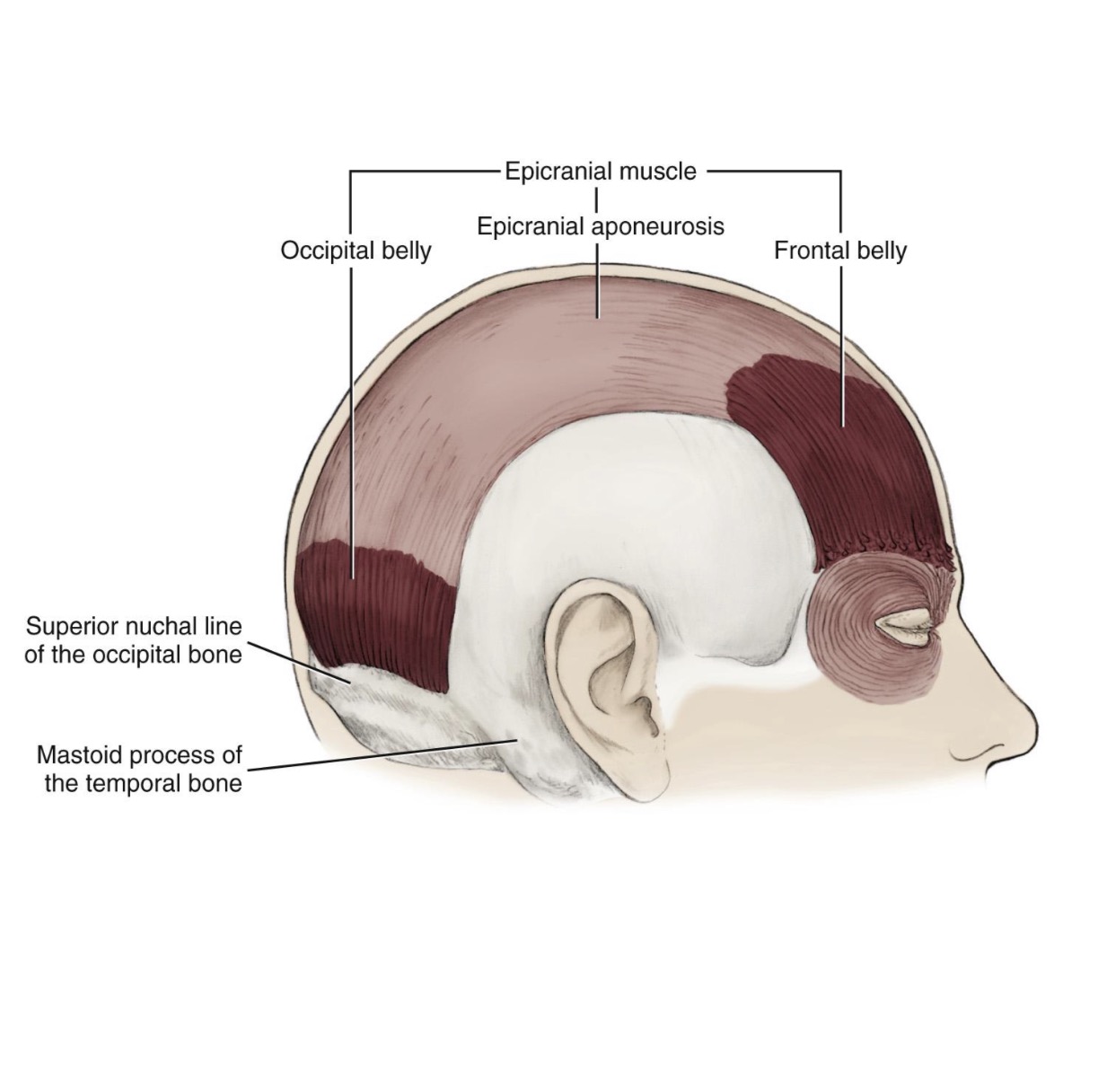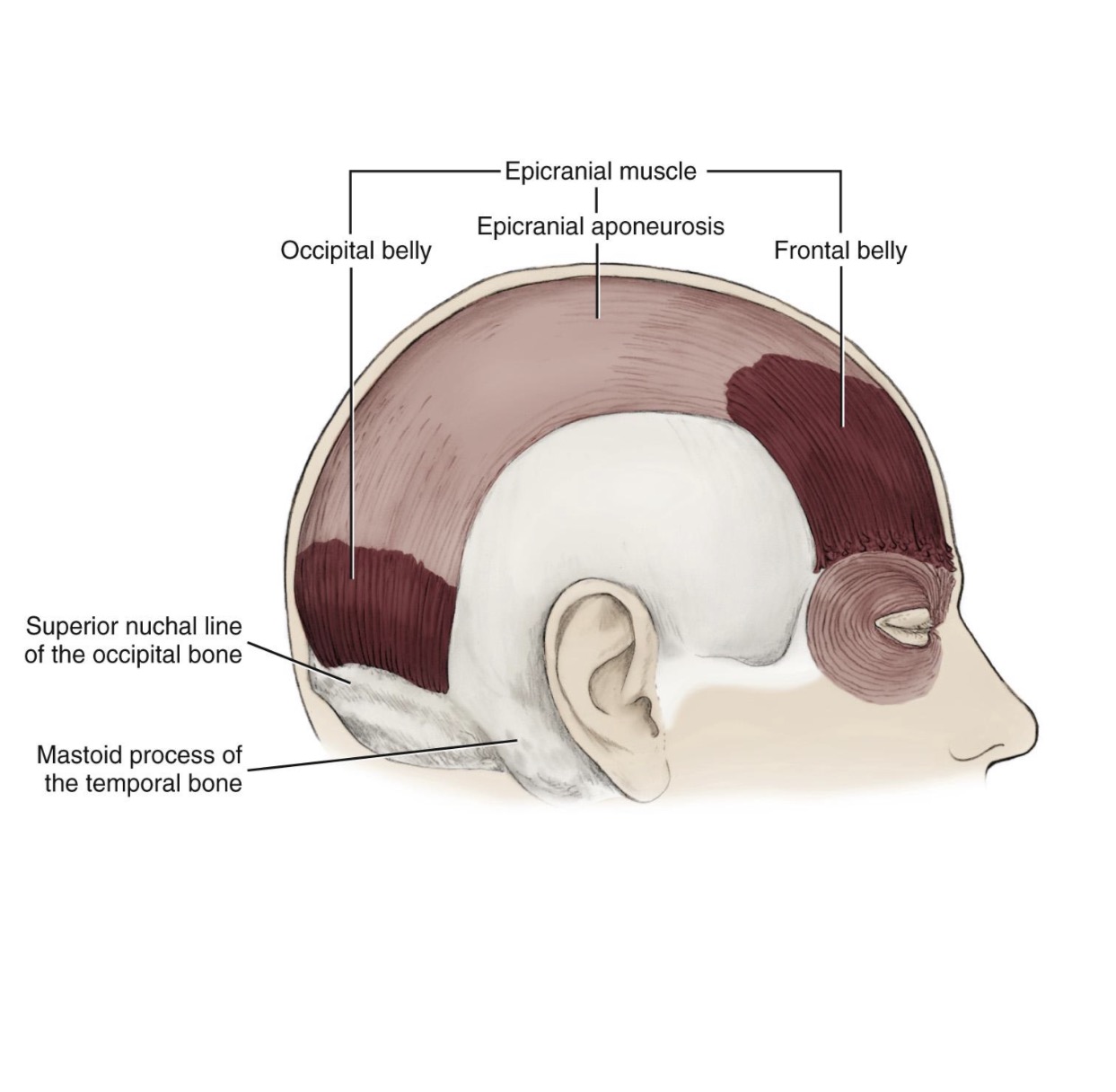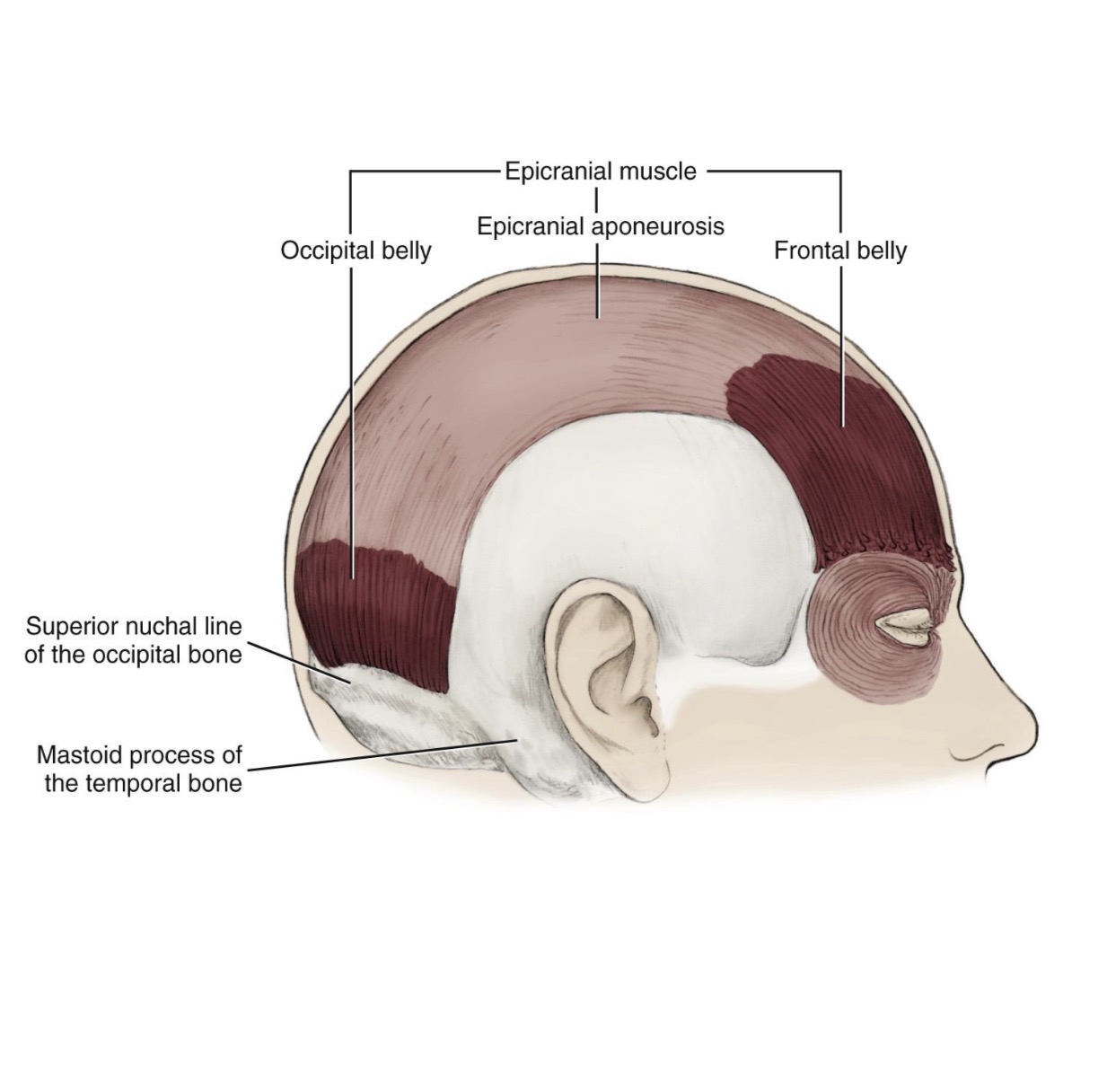Muscles part 1
1/66
There's no tags or description
Looks like no tags are added yet.
Name | Mastery | Learn | Test | Matching | Spaced |
|---|
No study sessions yet.
67 Terms
Cranial nerve VII Facial nerve branches:
temporal, zygomatic, buccal, mandibular
Passes through the parotid salivary gland.
FACIAL Nerve VII
Epicranius Frontal Belly origin
Epicranial aponeurosis.

Epicranius Frontal Belly insertion
Skin of eyebrow and root of nose.

Epicranius Occipital Belly insertion
Epicranial aponeurosis.

Epicranius Occipital Belly origin
Superior nuchal line, mastoid process.

Epicranial muscle action
Raise the eyebrows and scalp. Bellies can act independently.
Orbicularis oculi origin
Orbital rim, Frontal bone, Maxilla.
Orbicularis oculi insertion
Skin at the lateral canthus. Some fibers encircle the orbit.
Orbicularis oculi action
Closes the eyelid, Blinking, Squinting.
Corrugator supercilii origin
Frontal bone, Supraorbital region.
Corrugator supercilii insertion
Skin of the eyebrow.
Corrugator supercilii action
Draws the eyebrow in and downward
3 muscles of the nasal region…
nasalis, procerus, depressor septi nasi
The ______ is the largest and best developed of the group of nasal region muscles, which is active when the nares are flared.
Kissing muscle
Orbicularis oris.
Orbicularis oris origin
Encircle the mouth between the skin and labial mucosa of lips. No bony attachment.
Orbicularis oris insertion
Skin of the lips at both labial commissures.
Orbicularis oris action
Closing lips, Pursing lips, Grimacing, Pouting and kissing.
Thin quadrilateral muscle that forms the anterior part of the cheek or the lateral wall within the buccal region of the oral cavity.
Buccinator
Buccinator origin
Alveolar processes of maxillae and mandibule, Pterygomandibular fold/raphe.
buccinator insertion
maxilla/superior of pterygomandibular raphe inserts obliquely downward into lower lip, mandible/inferior of pterygomandibular raphe inserts obliquely upwards into upper lip
Buccinator muscle action
Pulls labial commissures laterally, shortening the cheek, Aids in chewing by keeping food in correct position.
what is the buccinator muscle known as?
the trumpet muscle
Risorius origin
Fascia over masseter.
Risorius insertion
Skin at labial commissure.
Risorius action
Stretches lip laterally, Retracts labial commissure, widening the mouth.
grimace muscle
Risorius.
Levator labii superioris origin
Infraorbital rim of the maxilla.
Levator labii superioris insertion
Skin of the upper lip.
Levator labii superioris action
Elevates the upper lip.
Levator labii superioris alaeque nasi origin
Frontal process of the maxilla.
Levator labii superioris alaeque nasi insertion
The skin of the ala of the nose, Upper lip.
Levator labii superioris alaeque nasi action
Elevates the upper lip and the ala of the nose, thus dilating each nares.
Sneering muscle
Levator labii superioris alaeque nasi.
zygomaticus major origin
zygomatic bone
zygomatic major insertion
labial commissure
Zygomaticus major action
Elevates the labial commissure and pulls it laterally.
Zygomaticus minor origin
Zygomatic bone.
Zygomaticus minor insertion
Skin of the upper lip.
Zygomaticus minor action
Elevates the upper lip.
Depressor anguli oris origin
Mandible.
Depressor anguli oris insertion
Labial commissure.
Depressor anguli oris action
Depresses the labial commissure.
what is the depressir anguli oris known as?
the frowning muscle
depressor labii inferioris origin
mandible
depressor labii inferioris insertion
lower lip
depressor labii inferioris action
depresses the lower lip, exposing the mandibular teeth
what is the depressir labii inferios muscle referred to as?
irony muscle, facial expressions of sarcam
mentalis muscle origin
mandible
mentalis msucle insertion
chin
mentalis muscle action
raises the chin causing the lip to protrude
Origin
The end attached to the least movable structure.
Insertion
The end attached to the more movable structure.
Sternocleidomastoid origin
Clavicle and sternum.
Sternocleidomastoid insertion
Mastoid process, superior nuchal line.
Sternocleidomastoid action
If one muscle contracts, head and neck bend to unilateral side, face and front of the neck rotate to contralateral side. If both muscles contract the head will flex at the neck and extend at the junction between the neck and skull.
Trapezius origin
Occipital bone, cervical and thoracic regions.
Trapezius insertion
Clavicle, scapula.
Trapezius action
Lift the clavicle and scapula, As when the shoulders are shrugged.
May be the first sign of damage to the seventh cranial (facial) nerve.
Inability to form facial expressions
Pterygomandibular fold
Tendinous band located posterior to the most distal mandibular molar.
Platysma origin
Skin clavicle and shoulder.
Platysma insertion
Mandible and muscles of mouth.
Platysma action
Vertical, horizontal ridges and depression in neck skin. Pulls labial commissures down.
SCM is innervated by….
accessory nerve (XI)
trapezius is innervated by»»
accessory nerve (XI), as well as 3rd and 4th